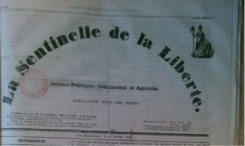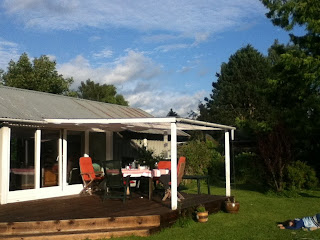Today's post comes from Erin Zavitz who recently traipsed around several European archives gathering research for her work on Haiti. Erin is a PhD candidate in the department of history and her work on Haiti shows just how connected European history is with other regional and national histories. So here is what Erin has to say about her tour of archives:
One of the most challenging and rewarding experiences of
research is successfully tracking down sources which are scattered across libraries
and archives. While my dissertation research focuses on nineteenth and
twentieth-century Haiti, relevant documents are held across the Americas and
Europe. After working in U.S. and Haitian institutions, I had the opportunity
to follow my source leads across the Atlantic—thanks to a Chateaubriand
Fellowship and a grant from the Center for European Studies.
Arriving in France in early February, I spent four months
researching in Paris and Nantes and working with graduate students and faculty
at the Centre International de Recherche sur les Esclavages (CIRESC). Initially
shocked by a season we see little of in Florida, WINTER, I found warm welcomes at Paris's marvelous archives and libraries.
My dissertation examines how Haitians have commemorated the
Haitian Revolution (1789-1804) in print, national holidays, and oral
traditions. In Paris, I focused on the first two commemorative traditions.
Working at the Bibliothèque Nationale, Archives Nationales, and Archives
Diplomatiques, I examined the only known copies of early Haitian writings,
historical and literary, on the revolution as well as nineteenth-century
newspapers and holiday speeches and proclamations.
|
La Sentinelle de la Liberté: Journal Politique, Commercial et Agricole, 4 Janvier 1843. Bibliothèque Nationale, Paris
|
 |
| Arsenal |
 |
| Richelieu-Louvois |
Traveling among the various Parisian institutions is a
voyage through the history of architecture and archives. Both the Bibliothèque
Nationale (BN) and Archives Nationales have multiple branches within the city,
which I visited. First is the BN Richelieu-Louvois. Spread over several
seventeenth-century luxury apartment homes, the library opened in the mid-1600s
and today holds special collections such as manuscripts, maps, and photographs.
Next is Arsenal that contains much of the BN’s collections of French literature
and is located in the sixteenth-century residence of the Grand Master of the
Artillery. The final site and where I spent most of time is BN François
Mitterrand. A collection of four towers, which hold the majority of the BN’s collection,
are linked by a garden and lower level research library.
 |
| François-Mitterand |
 |
| Pierrefitte-sur-Seine |
 |
| AN-Paris |
The architectural diversity of the BN branches is mirrored
in the two Archives Nationales (AN) collections I visited in Paris. The
original AN branch is located in the center of Paris in a group of
eighteenth-century city mansions. Here, I poured over consular reports from the
nineteenth-century that contained valuable details on Haiti’s economic and
political developments. The second and newest branch of the AN is located
outside of central Paris in the suburbs. Pierrefitte-sur-Seine is at the end of
metro line 13, and the ride out provides an ideal moment to catch up on reading
as it will take at least 30 minutes (or if like me you’re coming from the
southern edge of the city close to an hour) to reach the final stop. The branch
opened in January 2013 just before I arrived in Paris, so I had the opportunity
to be among some of the first to use the new facility. While the central Paris
branch is full of history and charm, the new addition is state-of-the-art and
worth the metro trip to suburbs.

Leaving the hustle and bustle of Paris, I got to spend three
weeks in the western city of Nantes (pictured to the left) working at a branch
of the Archives Diplomatiques.
The break from Paris was fabulous and I found
a slew of unexpected documents at the archives. The diplomatic holdings focused
on 20
th century Haiti and included programs for national holiday
festivals, newspaper clippings on the celebrations, and reactions of French
ambassadors. The archivists were extremely helpful and frequently suggested
additional collections that would be useful for my research. Beyond the
archive, Nantes was an ideal location to be working on commemorations. The city
has been working on its own memory, specifically the role of Nantes in the
Atlantic slave trade. It was fascinating to see how museum projects and public
spaces had incorporated the diverse sides of Nantes’s history. Lastly, for
outdoor enthusiasts, Nantes has a great network of bike paths and running
trails along the cities multiple rivers. After hours in the archive, running,
walking, or cycling through parks is a great way to unwind.
London Calling…
After months in France, I took advantage of the frequent
public holidays in May to hop across the English Channel to London. While a
long-weekend of sight-seeing would have been ideal, I mainly went to read a
rare collection of early nineteenth-century Haitian pamphlets. Recently, the
historical library collection of the British Foreign and Commonwealth Office
transferred on permanent loan to Foyle Special Collections at King’s College
London dozens of Haitian publications. The holdings, which include the only
known copies of the pamphlets, are integral to my study of printed
commemorations of the Haitian Revolution. These early authors were the first to
deal with the question of how to write the history of the Haitian Revolution.

|
Excerpt from Henry Christophe’s correspondence, this letter
comes only days after the assassination of Haiti’s first head-of-state,
Jean-Jacques Dessalines.
Copies des lettres et pièces écrits au général en
chef de l’armée d’Haïti
(Au Cap : Chez P. Roux, 1806). Foyle Special Collections, King’s College
London
|
To maximize my time, I e-mailed Foyle Special Collections in
advance and the archivists pulled all the materials I requested. When I
arrived, I immediately got to work reading and photographing the pamphlets.
Unlike my experiences in France with busy libraries and archives, I was the
only person all day at Foyle, what a luxury! On my second day in London, I
traveled to the British Library and examined documents on the 150th
anniversary of Haitian independence and several issues of a newspaper from the
early 1810s.
While my days were quite research-filled, I had a little
time to explore the area near my hotel. Stumbling upon a great priceline.com
deal, I stayed across the Thames from Parliament and Big Ben. This was my view
in the morning as I walked to the Tube station. Wow!
Further up the road, I got to see Westminster Abbey,
Buckingham Palace, and Hyde Park (where I went for a quick run between rain
showers).
In addition to being near some
of London’s main attractions, the hotel was next to a street food fair. Just as
food trucks and street food have become popular in Gainesville, London is
teaming with eclectic and cheap outdoor markets. The Real Food Market at the
Southbank Center runs Friday to Sunday and has an assortment of stands from
traditional British meat pies to BBQ to Polish pierogies. A list of vendors and
more info is at:
http://www.realfoodfestival.co.uk/. The Southbank market is just one of many street food
options in London. For travelers on a budget this is great option, especially
in the summer!
Now back in Gainesville I am busy sorting through photos and
notes and moving on the final dissertation stage, writing. My European archive
ramble has definitely provided plenty of sources as well as leads for future
projects.
 Welcome to Eurogator's Thanksgiving edition! We have much to be thankful for today - adequate lighting (thank you Vincent McLeod), no lines at Starbucks, grant applications filed on time, funny news stories (see for instance Russia's attempt to get its citizens in shape and in the mood for the Olympics by offering free subway rides for a few squats http://www.forbes.com/sites/andrewbender/2013/11/14/moscow-subway-station-lets-passengers-pay-fare-in-squats/), etc. But alas, such is the deserted university campus on a day before a holiday break. We truly do have much to be thankful for though and we hope that everyone has a safe and enjoyable break. With any luck, most of you will be able to spend some time at home with friends and family and not have to worry too greatly about upcoming exams, papers, and other assorted academic assignments.
Welcome to Eurogator's Thanksgiving edition! We have much to be thankful for today - adequate lighting (thank you Vincent McLeod), no lines at Starbucks, grant applications filed on time, funny news stories (see for instance Russia's attempt to get its citizens in shape and in the mood for the Olympics by offering free subway rides for a few squats http://www.forbes.com/sites/andrewbender/2013/11/14/moscow-subway-station-lets-passengers-pay-fare-in-squats/), etc. But alas, such is the deserted university campus on a day before a holiday break. We truly do have much to be thankful for though and we hope that everyone has a safe and enjoyable break. With any luck, most of you will be able to spend some time at home with friends and family and not have to worry too greatly about upcoming exams, papers, and other assorted academic assignments. "Global Society was founded in 2000 at Santa Fe College for the purpose of providing students with a deep interest in international affairs. It is a group to socialize, and eventually, participate in Model United Nations conferences. Since its inception, Global Society has managed to win awards and recognition at these conferences nationwide. We compete against Ivy League and major universities by portraying our chosen country as accurately and diplomatically as possible. This allows an opportunity for students with an interest in engaging as a UN delegate and in attempting to resolve major world issues to learn more. As for our campus events, Global Society hosts lectures, fundraisers, dignitaries, and other social events throughout the semester. Thus, we are active throughout the year by preparing for these events and partaking in them. Global Society events consistently deliver a global message to the campus and community participants in an attempt to spread multicultural awareness.
"Global Society was founded in 2000 at Santa Fe College for the purpose of providing students with a deep interest in international affairs. It is a group to socialize, and eventually, participate in Model United Nations conferences. Since its inception, Global Society has managed to win awards and recognition at these conferences nationwide. We compete against Ivy League and major universities by portraying our chosen country as accurately and diplomatically as possible. This allows an opportunity for students with an interest in engaging as a UN delegate and in attempting to resolve major world issues to learn more. As for our campus events, Global Society hosts lectures, fundraisers, dignitaries, and other social events throughout the semester. Thus, we are active throughout the year by preparing for these events and partaking in them. Global Society events consistently deliver a global message to the campus and community participants in an attempt to spread multicultural awareness. 



























